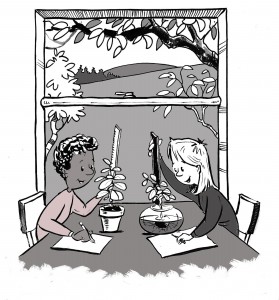From Stems to STEM

Originally appears in the Winter 2016 issue
When environmental science education starts in the early childhood years, it can help us to grow “green” children, who will naturally mature into “green” adults and citizens. In the early years, the best type of learning occurs when students have a chance to explore how the natural world around them works. Yet, children are always ever curious about the human-designed world as well. Providing children with opportunities to also consider the mechanisms we use to invent and affect our future opens doors to the world of engineering design. Inquiry and design work hand-in-hand to explain how our environment works alongside the role humans play—for good or for bad. In this circumstance we will use the process to reveal ways in which humans can act as problem-solvers in our ecosystem.
Plant growth and development is a common environmental science topic in the second grade. Understanding the processes that plants use to survive and thrive is essential for understanding the role they play in ecosystems. Though many early elementary curricula include some study of plants and ecosystem dynamics, most stop short of including the ways in which humans participate in these processes. While large-scale environmental issues such as deforestation and eutrophication are sometimes covered in plant units at later years, the use of human-designed systems to enhance plant growth, maximize space, and solve the problems related to food deserts are rarely addressed. In line with the need to approach our teaching and learning with hopefulness and as an opportunity for growth and change, the design process can help us to re-frame the roles of humans in ecosystems as builders and creators rather than destroyers of the earth.
The engineering design process includes the following steps: identify the problem, research, develop possible solutions, choose the best solution, create a prototype, test and evaluate, and redesign. The process is continuous – and repetitive – in order to ensure the best possible outcome. It is crucial to introduce this thinking process at the early childhood stages to encourage all students to understand environmental systems and issues, and to be able to create and design solutions. In the following, we present a series of lessons that integrate the engineering design process into the life sciences.
The following lessons explore the ideas presented in the Next Generation Science Standards for early childhood education related to the interdependent relationships in ecosystems and engineering design. This instructional unit is intended to be used with students who have already been exposed to the basics of the plant life cycle. It begins with an exploration of pollination, and an opportunity for students to create a model flower using the design process. Next, the students will investigate which factors are necessary for plant growth, namely water and sunlight. Finally, the students will create a hydroponic gardening system to explore whether plants need soil for growth, and then research how these systems can be used to address environmental issues.
To view the photo-rich magazine version, click here.
If you are not already a subscriber, please subscribe to read the full article
Lauren Madden is an Assistant Professor of Elementary Science Education and Coordinator of the Environmental Sustainability Education Minor at The College of New Jersey in Ewing New Jersey. Her teaching and research focus on helping children become inquisitive explorers and responsible stewards of the world around them. Courtney McGovern graduated magna cum laude from The College of New Jersey, in 2015, with a dual degree in Early Childhood Education and Integrative STEM (Science, Technology, Engineering, and Math). She is currently a Technology Teacher in the Academy of Fine Arts and Academics at Bayonne High School.
Endnotes
[i] Disney’s The Beauty of Pollination, http://video.disney.com/watch/the-beauty-of-pollination-wings-of-life-4da84833e06fd54fff590f49
[ii] Gibbons, Gail. (2000). The Honey Makers. Turtleback Books.
[iii] An example hydroponics webquest http://azteacher.net/past_students/mickelson/webquest4.htm
Leave a Reply
You must be logged in to post a comment.





